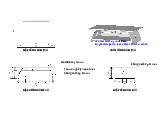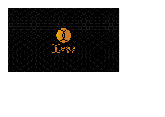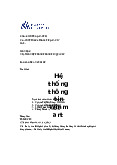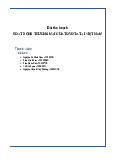



















Preview text:
Scope and Sequence Units Lessons y , g Lesson 1: What is technology? , o e ring
Unit 1: The Design Process nc e chnol
Lesson 2: What are objects made of? E B H I T G cie ine
How do you solve problems S Te ng E nd
Lesson 3: What is the design process? a
Lesson 1: What do living things need?
Unit 2: Living Things and
Lesson 2: How do plants and animals live in Their Environments land environments? E B H I T G
What do plants and animals need?
Lesson 3: How do plants and animals live in e water environments? nc cie
Unit 3: Plants and Animals
Lesson 1: What are some groups of living things? S E B I TH G
How are living things alike
Lesson 2: How are living things like their parents? Life and different?
Lesson 3: How are groups of living things different? Unit 4: Body and Health
Lesson 1: What can I do to stay healthy? E B H I T G
What do I need to be healthy?
Lesson 1: How can I stay healthy and safe? Unit 5: Earth and Sky Lesson 1: What is on Earth? E B H I T G
What can you say about Earth Lesson 2: What changes land? ce and sky? n Lesson 3: What is the sun? cie S Lesson 1: What is weather? rth a Unit 6: Weather E HE B I T G
Lesson 2: How can you measure weather?
How can you describe weather?
Lesson 3: What are the four seasons? Lesson 1: What is matter? Unit 7: Matter
Lesson 2: What are solids, liquids, and gases? HE B I T G
How can you describe matter?
Lesson 3: How can matter change? e nc
Lesson 1: How do we use energy? cie Unit 8: Energy l S Lesson 2: What is light? HE B I T G What can energy do? sica Lesson 3: What is sound? Phy Unit 9: Movement
Lesson 1: How objects can move? E B H I T G
How can you describe ways Lesson 2: What is a force? objects move? Lesson 3: What is gravity? x Scope and Sequence I will learn... Key Words
• how technology helps people solve problems.
• technology, science, scientist, discovery
• what materials different objects are made of.
• materials, natural, wood, cotton, rock, plastic
• to explain the design process.
• goal, solution, problem, plan, label • what living things need.
• need, air, water, light, nutrients, soil, shelter
• how plants and animals can live in land environments.
• environment, forest, prairie, desert
• how plants and animals can live in water environments.
• wetland, swamp, marsh, ocean
• seed, cone, backbone, mammal, reptile, amphibian,
• ways to group living things. insect
• how living things are like their parents.
• parent, young, alike, shape, different
• how living things are alike and different.
• petunia, fuzzy, herd
• what some healthy habits are.
• healthy, habit, eating well, exercise, cavity, check up
• germs, sicvwk, sneeze, skin, heal, cut, bandage,
• how I can stay healthy and safe. helmet, life jacket
• to describe the land, water, and living things.
• plain, hill, mountain, island, river, lake, ocean
• about the fast and slow Earth changes.
• earthquake, weathering, erosion
• ways the sun helps and harms things on Earth.
• gas, warm, heat, harm, sunglasses
• weather, storm, safe, thunderstorm, shelter, tornado, • to describe weather. hurricane, snowstorm
• measure, tool, thermometer, temperature, rain gauge, • how to measure weather. win vane
• how the weather changes in each season. • season
• to defi ne matter and describe objects by their properties. • matter, mass, weight, fl oat, sink, temperature
• to identify solids, liquids, and gases.
• solid, liquid, gas, freeze, melt, boil • ways matter can change. • iron, rust, oxygen • how to use energy.
• electricity, energy, fuel, gasoline, engine, battery, key • what light can do. • light, shadow • how to make sounds.
• sound, vibrate, loud, soft, high, low
• move, straight, curved, around, zigzag, speed, quickly, • how objects can move. slowly
• how forces change the way things move.
• force, push, pull, direction, motion
• that gravity pulls objects toward Earth. • gravity, ground Scope and Sequence xi Unit The Design Process 1 How do you I will learn
solve problems? ō how technology helps people solve problems. 1 ō what materials different Look and circle the tools objects are made of. they are using.
ō to explain th e design process. Think!
2 Think of something you want to make. Name the tools you What are the father and son in this picture will need. making? 4 Unit 1
Lesson 1 . What is technology? Key Words
1 Read, look, and mark ( ō technology ) the tool ō science the boy is using. ō scientist Technology ō discovery Technolo y g is using science to help
solve problems. Computers are a
kind of technology. Scientists use
technology to make discoveries. Sometimes scientists discover new technologies. Technology h
scientists to do their work.
2 Do we use all these inventions now? Say as a class. 1870 1876 1946 The first al metal bicycle. The first telephone cal . The first computer. Let’s Explore! Lab Unit 1 5
3 Read and underline a problem that technology solves. Solve Problems Technology helps people solve
problems. One problem is that people
need to communicate with each other.
They might not be in the same place.
They can use a telephone. A telephone is technology.
The boy uses a pencil to communicate. A pencil is technology.
4 Look and circle other examples of technology.
5 Look at the timeline on page 5. Number
the inventions 1, 2, or 3 in the
order they were invented. Think! What would you like to invent? 6 Unit 1 I Will Know...
6 Read. What are three kinds of technology a car can have? Say with a partner. Staying Safe
Technology helps people stay safe.
People use cars to get from place to
place. Seat belts and airbags help make cars safe. Safety seats
help children keep safe in a car.
Technology helps people stay safe in cars.
7 Draw another kind of technology that helps people solve problems. Helping Earth Think of a technology that helps keep the air or water clean. Tell how it helps. Lesson 1 Check Got it? 60-Second Video Unit 1 7
Lesson 2 . What are objects made of?
1 Read. Look and point to Key Words three objects in the park ō materials ō cotton that people made. ō natural ō rock ō wood ō plastic Different Materials
People use materials to make objects. Some materials are
natural. Natural means not made by people. Materials that
come directly from Earth are natural. Wood and cotton are
natural. Rocks and minerals are natural, too. Sometimes people use natural materials to make new materials. Plastic is a material people make.
2 Look at the photo. Circle one material that is natural and cross out ( ) one material that is made by people. 8 Unit 1 Explore My Planet!
3 Read. Look and color the frame
around the materials you might use to build a house. Natural Materials
Natural materials are different from each
other. People use them in different ways.
Wood and rocks are hard. People
use them to make buildings. Cotton
is soft. People use cotton to make clothes.
4 Write one kind of material you might use to make a pillow.
5 What material is soft? What materials are hard? Say with a partner. I Will Know... Unit 1 9
6 Read and write two things
people can make out of plastic. Man-Made Materials
People make new materials, and they
use them in different ways. Plastic
is a new material. Some plastic is
hard, and some plastic is soft. People
use more than one material to make
some objects. They can use plastic and wood to make a chair. A plastic cup can hold food or a drink. Materials Find two objects. Tell what materials people used to make them. Tell if the materials are natural or people made them.
Packing foam is a soft type of plastic. 10 Unit 1 Lesson 2 Check Got it? 60-Second Video
Lesson 3 . What is the design process? Key Words
1 Read. Circle the problem and underline the goal. ō goal ō plan ō solution ō label A Problem and a Goal ō problem
Wood ducks are animals that need
shelter. First, you set a goal, to design a house for wood ducks. A goal is something you want to do. Your house for wood ducks will be a solution. A solution solves a problem.
Wood ducks do not make their own shelters.
They use shelters that people or other animals make.
2 Draw a house for a wood duck. Plan and Draw
Next, you make a plan to build
your house for wood ducks. You write about how to make your
house for wood ducks. You draw
what your house for wood ducks will look like. Let’s Explore! Lab Unit 1 11
3 Read. Look and circle three materials you need to make a house for wood ducks. Choose Materials
Next, you decide what materials to use
to make your house for wood ducks.
You might choose wood for the walls.
You might choose nails to hold the walls
together. You need something on the
inside so the wood ducks can climb out.
You might choose a piece of screen. 12 Unit 1 I Will Know...
4 Read. How do you know your house for wood ducks
works well? Say with a partner. Test
Next, you make your house for wood ducks. You check
the house every day. You see if wood ducks live there.
5 Read, look, and label the details of the house for wood ducks. Record and Share
You decide how your solution works. You plan again to
make your solution better. You write and draw to tell about
your solution. You use labels to show parts of your solution. Lesson 3 Check Got it? 60-Second Video Unit 1 13 Materials Let’s Investigate! gram cubes How can you build a boat?
1. Design a boat that will float. foil Draw your design. 2. Build your boat. plastic tub of water 3. Add gram cubes to your boat until it sinks. Record.
4. Redesign your boat to hold more cubes. Predict how many gram
cubes it will hold before it sinks. Record. 14 Unit 1
Let’s Investigate! Lab Unit 1 Review
How do you solve problems? Lesson 1 What is technology?
1 Circle the word that best completes the sentence.
Technology helps solve ________. Lesson 2
What are objects made of?
2 Circle the object with no natural materials. Lesson 3
What is the design process?
3 How can you test an ant farm? Underline the answer. a. put food inside c. draw the ant farm
b. tell about the ant farm d. see if ants live there Got i ? t Quiz Got i ? t Self Assessment Unit 1 15 Unit Living Things and 2 Their Environments What do plants I will learn
and animals need? ō what living things need. ō how plants and animals
1 Circle where cows live. can live in land and water environments.
2 Cross out ( ) what a cow does not need.
3 Look and circle the products we get from cows. Think of two more. Think! Why do cows need the sun? 16 Unit 2
Lesson 1 . What do living Key Words things need? ō need ō nutrients
1 Look and draw one missing thing ō air ō soil ō water ō shelter that the plant needs to grow. ō light Read. Needs
All living things have needs. A need
is something a living thing must
have to live. Plants and animals
Poppy plants have needs.
are living things. They have needs. People have needs, too. Needs of Plants Plants need air and wa w t a er e . They
need light to make food. They need space to live and grow.
2 Why do the poppy plants look
healthy? Talk about it as a class. Let’s Explore! Lab Unit 2 17
3 Read. Look and point to where
the strawberry plants get nutrients. Nutrients
Plants need nutrients. Nutrients are materials
that living things need. Plants can get nutrients from the soil.
4 Why do strawberry plants need nutrients? Say with a partner.
5 Look and complete the chart. 18 Unit 2 I Will Know...
6 Read. What do animals and people need? Say with a partner. Needs of Animals
Animals need air, water, and food. They get nutrients from food.
Beavers build their own shelter. Animals need space to live. Some animals need shelter. Shelter is a safe place. Needs of People
People need air, water, and food. They get nutrients from food.
People need space to live. They
need shelter. Shelter keeps them warm and dry.
7 Match what plants and animals need. Lesson 1 Check Got it? 60-Second Video Unit 2 19
Lesson 2 . How do plants and animals
live in land environments?
1 Read. Look at the picture and Key Words say two things you think are ō environment ō prairie in the horses’ environment. ō forest ō desert Environments
An environment is all the living and
nonliving things in one place. It has
food, water, and air. Land is one kind of
environment. Land has rocks and soil.
Many plants and animals live on land.
2 Read. With a partner, describe the forest. Forest Environments
A forest is a land environment. It is
land that has many trees and other
plants. Black bears live in some
forests. They have sharp claws. Bears
use their claws to dig for food. Sharp claws help bears climb trees. Think! Why did the bear climb the tree? 20 Unit 2 Explore My Planet!




